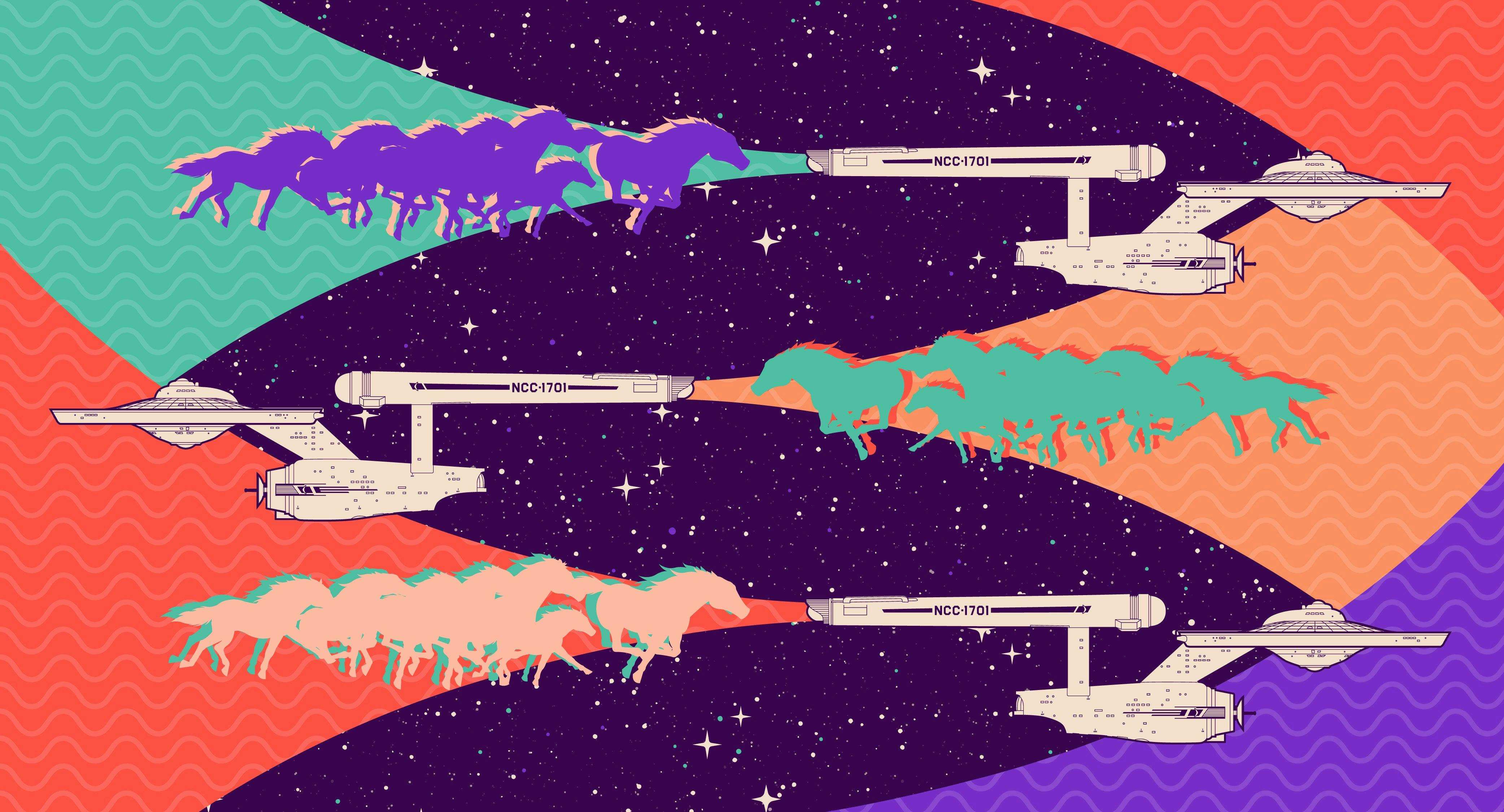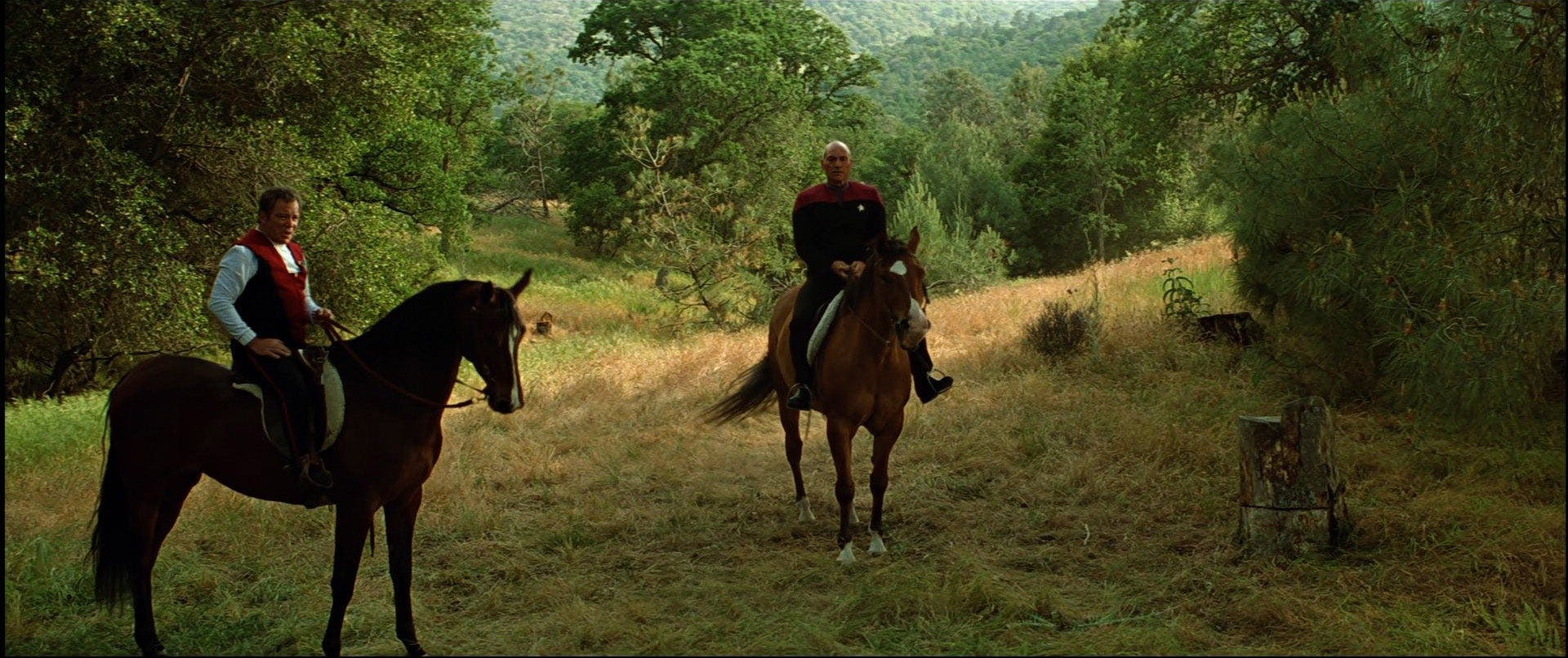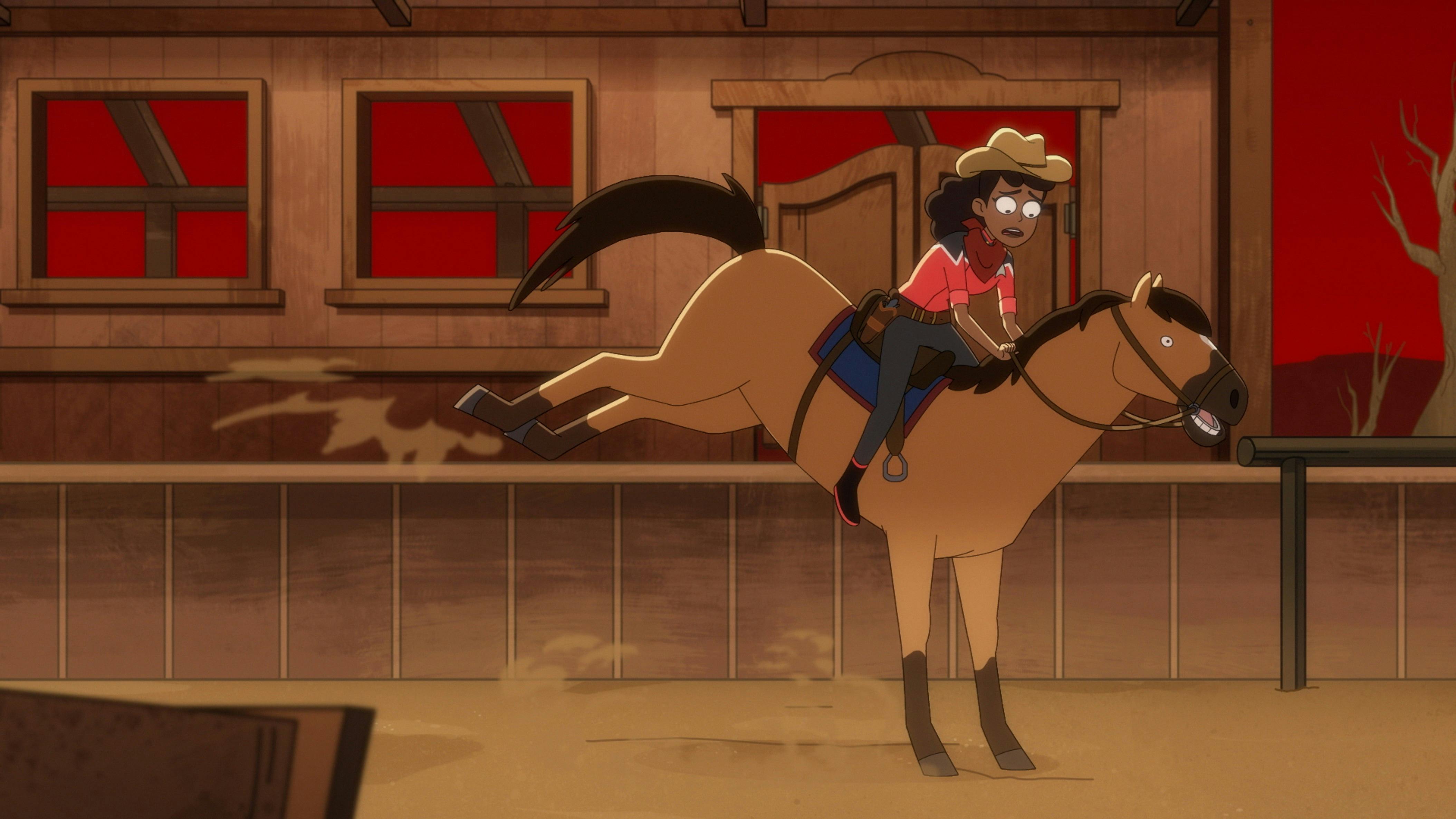Published Apr 4, 2022
Star Trek Versus Horses
A study of captains (and ensigns) and their noble steeds

StarTrek.com
In the final frontier, you don’t have to choose between riding a horse and riding a starship. In the world of Star Trek, you can have both at the same time. Perhaps there is no greater achievement in science fiction than to dream of a point in the future in which people on massive starships would want to take a break from traveling through the cosmos and pretend to ride a horse. Imagine going back in time and telling H.G. Wells that, yes, those books were far-out, but have you thought of putting someone who lives on a spaceship also on a horse?
There’s a somewhat obvious reason why horses are so prevalent throughout Star Trek, and it’s right there in the “final frontier.” The notion of a frontier evokes the idea of a western, something which Star Trek creator Gene Roddenberry drew upon for inspiration when crafting his earliest pitches for the series. And, some of Roddenberry’s best TV writing before Star Trek was on the Western Have Gun — Will Travel, in which an ethical lone gunslinger named Paladin (Richard Boone) went from town to town righting wrongs. If you watch a random episode of Have Gun written by Roddenberry, it’s easy to squint and see aspects of all the Trek captains when Paladin gives some of his stirring speeches. Clearly, the idea of action heroes who also have big hearts and moral compasses was integral to coaxing The Original Series into what it became. And, because Paladin rode a horse, it helps to explain why so many characters through all of Star Trek ride horses, too.
Don’t think there’s a lot of horse riding in Trek? Here are just a few examples of people saddling up in Trek: Pike has horses in the TOS episode “The Cage,” Picard rides a holographic horse in TNG’s “Pen Pals,” Picard rides horses with Kirk in the film Generations, Kirk and Spock steal and then ride horses in The Final Frontier, Archer, Trip and T’Pol ride horses in the Enterprise episode “North Star,” Mariner is thrown off of a holographic horse in the Lower Decks episode, “I, Excretus,” and Captain Pike is riding a horse in the first thrilling trailer for Star Trek: Strange New Worlds.
Teaser Trailer | Star Trek: Strange New Worlds
Giddy-up! That’s a lot of horses! But, beyond pop-culture history factoids that explain why so many horses appear in Star Trek, what’s way more fun is to try and figure out what horses actually mean when they appear in Star Trek. The significance of a horse in Star Trek feels both more special than, say, than a horse in another big media franchise not normally about horses.
At the same time, seeing a horse in Star Trek never feels out of place. If Batman rode a horse, people would be shocked. When Pike, Kirk, Picard, or Archer rides horses, it feels normal and even correct. This idea would lead us back to the notion that horses in Star Trek feel normal because Star Trek has some very old-fashioned heroes-atop-horses motifs baked into its mythology; either from westerns or fairy tales. This line of thinking is tempting and would go like this: Pike and Kirk like horses because the characters were created (or evolved from) a certain ethos the American entertainment industry had about heroes who rode horses.
But this explanation doesn’t quite work within the narrative framework of Star Trek. And the reason why becomes clear when you think about the context in which Star Trek characters often ride horses; specifically, the idea that horses tend to be a fantasy within a fantasy; a person riding a horse while also in space. In other words, Star Trek rarely presents the horse-riding thing plainly. There’s almost always a wrinkle and visual juxtaposition.
With some exceptions — like The Final Frontier — characters in Trek are usually not riding horses to gallop in and save the day. Instead, because the vast majority of horses in Star Trek are not real horses, then the visage of seeing a Star Trek character interact with horses is more about seeing a Star Trek character with old-fashioned, terrestrial hobbies. Up until Strange New Worlds, Pike’s canonical horses in “The Cage” were both actually telepathic illusions. Ditto Picard and Kirk’s horses in Generations. And in the TNG episode, “Pen Pals,” Picard's horse was holographic. Even a fairy-tale-esque knight on a horse in the TOS classic “Shore Leave” is later revealed to be a robot.

StarTrek.com
In the new Strange New Worlds trailer, we see Captain Pike riding a horse until he’s buzzed by a Starfleet shuttle. The character Donald Kauffman (Nicholas Cage), from the film Adaptation, would probably describe this scene as “technology versus horse,” implying our brains are supposed to think deeply about what’s similar and what’s different about these modes of transportation. The teaser poster for Strange New Worlds shows Pike on a horse while gazing lovingly at the Enterprise. But what’s amazing is this: someone who has never seen Star Trek could intuitively understand that the poster is not suggesting that this is a show about a guy who brings a horse to live on a spaceship with him. Star Trek has succeeded in making literal horses metaphors simultaneously. Wild!
This single trick might be one reason why Star Trek is so successful. A mixed metaphor like juxtaposing a starship with a horse is both simple and complex. You get it without having to think about it too hard, but you’re not sure why. It’s a kind of shorthand with layers. And best of all, Star Trek does not present a universe in which everyone is obsessed with horses. Only some characters have the horse-riding bug. In The Final Frontier, Kirk barks at Spock, “Spock, be firm with the horse!” Now, the curious incident of Kirk schooling Spock about how to ride horses is that it proves Starfleet doesn’t require you to know how to ride horses. There’s a knowledge gap when it comes to horseback riding within the Federation. In TNG’s “Starship Mine,” the rest of the bridge crew, and Troi in specific, are generally bemused at Picard’s assertion of being a “serious rider.” The message is clear: Picard’s hobby is not common even if it is accepted by society at large.
In contemporary culture, you could argue that knowing how to ride a horse is something connected with class or occupation. If you don’t work with horses professionally, or didn’t take horse riding lessons, you may not know how to ride. In Lower Decks' “I, Excretus,” when Mariner’s horse-riding skills result in disaster Captain Freeman later jokes “two and a half years of lessons and that’s what you had to show for it!” But, Mariner’s frustration with the holographic “Old West Planet” simulation is understandable. Knowing how to ride a horse is a quirk in the world of Star Trek, but it’s not necessarily a skill everyone in Starfleet must possess. At the start of the “Old West Planet” drill, Mariner says “Trapped in cowboy land! A Starfleet classic! Yee-Haw!” This references several western-themed episodes, some of which (like “Spectre of the Gun” in TOS) don’t actually even feature anyone riding a horse. Mariner even points out that her having to ride the horse to get somewhere feels like a “very narrow mission parameter,” and that’s because even though tropes from westerns are deeply embedded in the history of Star Trek, the actual storytelling of Star Trek isn’t permanently tied-to these tropes at all. Mariner calling “Old West Planet” a “Starfleet classic” is complicated. Westerns are a huge part of how Star Trek came into existence, but that doesn’t mean every single instance of a western trope within Trek is an homage. Instead, what the preponderance of horses in Star Trek proves is something else. In Star Trek, you have Star Trek horses, and they’re not like horses in any other fiction

StarTrek.com
Whether it's Pike or Mariner on a horse, the image of a hero galloping into danger isn’t just evocative of westerns and fairy tales. What makes Star Trek such a unique art form is that it can pool from various fictional genres without being utterly beholden to those genres either. Horses in Star Trek are both real and imagined, and unlike horses in any other fictional world, they don’t represent just one thing. Sometimes, a horse is just a horse, but in Star Trek, a horse can literally be anything.
Ryan Britt (he/him) is the author of the forthcoming non-fiction book Phasers On Stun! How the Making (and Remaking) of Star Trek Changed the World, out from Plume Books on May 31, 2022. His science fiction journalism and criticism appear regularly with Inverse, Den of Geek!, Vulture, and Star Trek.com. His other writing has been published with SyFy Wire, VICE, the New York Times, and elsewhere. Ryan is an editor at Fatherly and lives in Portland, ME with his wife and a daughter who adores tribbles.
Star Trek: Strange New Worlds will stream exclusively on Paramount+ in the U.S., Latin America, Australia & the Nordics. The series will air on Bell Media’s CTV Sci-Fi Channel & stream on Crave in Canada with additional international availability to be announced at a later date. The series is distributed by Paramount Global Content Distribution.
Star Trek: Lower Decks streams exclusively in the United States and Latin America on Paramount+, on Amazon Prime Video in Australia, New Zealand, Europe, Japan, India and more, and in Canada on Bell Media’s CTV Sci-Fi Channel and streams on Crave.

